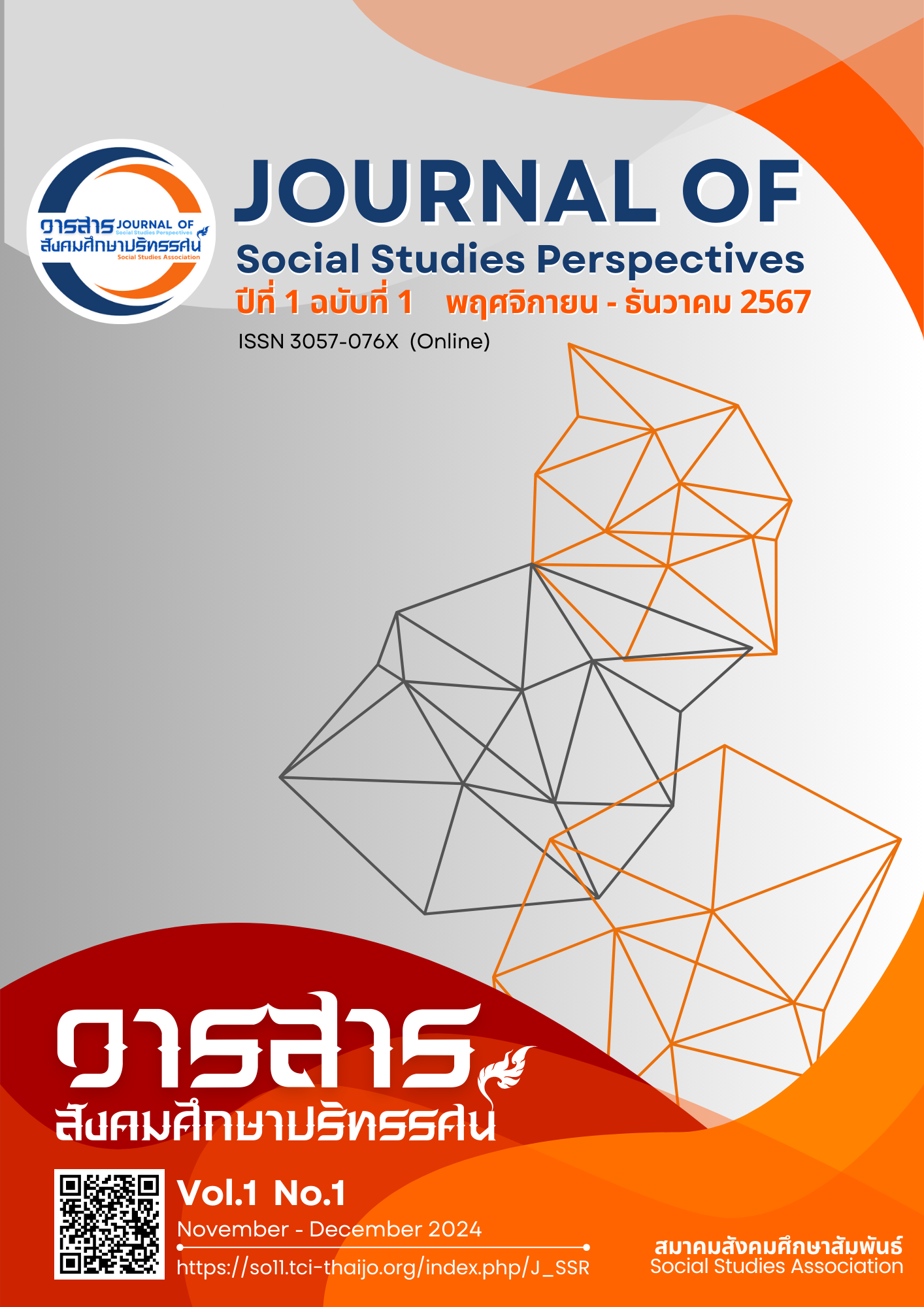การออกแบบอินโฟกราฟิกตามทฤษฎีประมวลสารสนเทศ
DOI:
https://doi.org/10.64186/jsp1080คำสำคัญ:
อินโฟกราฟิก, ทฤษฎีการประมวลสารสนเทศ, กระบวนการรับรู้บทคัดย่อ
ในยุคดิจิทัลที่ข้อมูลถูกถ่ายทอดอย่างรวดเร็ว การนำเสนอสารสนเทศในรูปแบบอินโฟกราฟิกจึงเป็นเครื่องมือสำคัญที่ช่วยลดความซับซ้อนของข้อมูลให้เข้าใจง่ายและดึงดูดความสนใจของผู้เรียนการออกแบบอินโฟกราฟิกตามทฤษฎีการประมวลสารสนเทศมีบทบาทสำคัญในการทำให้ข้อมูลถูกนำเสนออย่างมีระบบและเข้าใจง่าย กระบวนการออกแบบที่สอดคล้องกับทฤษฎีนี้เน้นการประมวลสารสนเทศที่มีประสิทธิภาพผ่านการจัดลำดับข้อมูล การใช้สีและสัญลักษณ์ที่ดึงดูดสายตา และการนำเสนอข้อมูลที่กระชับและน่าจดจำโดยทฤษฎีนี้เน้นกระบวนการรับรู้ ความจำ และการเรียกคืนข้อมูลซึ่งเป็นองค์ประกอบหลักในการออกแบบอินโฟกราฟิกให้มีประสิทธิภาพสูงสุดสำหรับการเรียนรู้ การออกแบบตามทฤษฎีนี้ช่วยลดภาระทางความคิด ทำให้ผู้เรียนจดจำเนื้อหาได้ดีขึ้น บทความนี้มุ่งเน้น การออกแบบอินโฟกราฟิกที่เพิ่มประสิทธิภาพ การเรียนรู้ผ่านการวิเคราะห์ข้อมูล วางแผนการสื่อสาร ปรับแต่งเพื่อสร้างสื่อที่ตรงตามกระบวนการรับรู้และความจำของผู้เรียน
เอกสารอ้างอิง
Khruafak, C (2021). Infographic media and information dissemination to cope with the COVID-19 crisis. Journal of Liberal Arts, Ubon Ratchathani University, 17(1), 47–67.
Charoenyot, T (2023). Development of an infographic prototype for communicating remote physical therapy practices during the COVID-19 pandemic. Journal of Communication and Innovation NIDA, 10(2), 1–33.
Pramanee, N (2017). Design and application of infographics in the present. Southern Technology Journal, 10(1), 159–169.
Kullimratchai, P (2021). Infographic design: Techniques, tools, and applications. Eastern University Academic Journal, 15(2), 3.
Wimano, P (2023). Infographic design integrated with augmented reality technology for learning at Phatthamon Farm. Journal of Information Technology, 19(1), 1–8.
Chansuwan, W (2020). Infographic (Basic concepts). Retrieved October 20, 2024, from https://web.rmutp.ac.th/woravith/?page_id=1991
Yodsanoha, S (2024). Infographic design for awareness of call center threats. Journal of Humanities and Social Sciences, 2(1), 29–37.
Atkinson, R. C., & Shiffrin, R. M. (1968). Human Memory: A Proposed System and its Control Processes. The Psychology of Learning and Motivation, 2, 89–195.
Baddeley, A. D. (1992). Working Memory. Science, 255(5044), 556-559.
Clark, R. C., & Lyons, C. (2011). Graphics for Learning: Proven Guidelines for Planning, Designing, and Evaluating Visuals in Training Materials. San Francisco: Pfeiffer.
Few, S. (2012). Show Me the Numbers: Designing Tables and Graphs to Enlighten (2nd ed.). Burlingame, CA: Analytics Press.
Kahneman, D. (1973). Attention and Effort. Englewood Cliffs, NJ: Prentice-Hall.
Kosslyn, S. M. (2006). Graph Design for the Eye and Mind. New York: Oxford University Press.
Krum, R. (2013). Cool Infographics: Effective Communication with Data Visualization and Design. Indianapolis, IN: Wiley.
Lidwell, W., Holden, K., & Butler, J. (2010). Universal Principles of Design. Beverly, MA: Rockport Publishers.
Mayer, R. E. (2009). Multimedia Learning (2nd ed.). New York: Cambridge University Press.
Mayer, R. E., & Moreno, R. (2003). Nine Ways to Reduce Cognitive Load in Multimedia Learning. Educational Psychologist, 38(1), 43–52.
Paivio, A. (1990). Mental Representations: A Dual Coding Approach. New York: Oxford University Press.
Smiciklas, M. (2012). The Power of Infographics: Using Pictures to Communicate and Connect with Your Audiences. Indianapolis, IN: Que Publishing.
Sweller, J. (1988). Cognitive Load During Problem Solving: Effects on Learning. Cognitive Science, 12(2), 257-285.
Sweller, J., Ayres, P., & Kalyuga, S. (2011). Cognitive Load Theory. New York: Springer.
Tufte, E. R. (2001). The Visual Display of Quantitative Information (2nd ed.). Cheshire, CT: Graphics Press.
Ware, C. (2004). Information Visualization: Perception for Design (2nd ed.). San Francisco: Morgan Kaufmann.
Ware, C. (2012). Information Visualization: Perception for Design (3rd ed.). Burlington, MA: Morgan Kaufmann.
ดาวน์โหลด
เผยแพร่แล้ว
รูปแบบการอ้างอิง
ฉบับ
ประเภทบทความ
หมวดหมู่
สัญญาอนุญาต
ลิขสิทธิ์ (c) 2024 วารสารสังคมศึกษาปริทรรศน์

อนุญาตภายใต้เงื่อนไข Creative Commons Attribution-NonCommercial-NoDerivatives 4.0 International License.
บทความนี้ได้รับการเผยแพร่ภายใต้สัญญาอนุญาต Creative Commons Attribution-NonCommercial-NoDerivatives 4.0 International (CC BY-NC-ND 4.0) ซึ่งอนุญาตให้ผู้อื่นสามารถแชร์บทความได้โดยให้เครดิตผู้เขียนและห้ามนำไปใช้เพื่อการค้าหรือดัดแปลง หากต้องการใช้งานซ้ำในลักษณะอื่น ๆ หรือการเผยแพร่ซ้ำ จำเป็นต้องได้รับอนุญาตจากวารสาร










